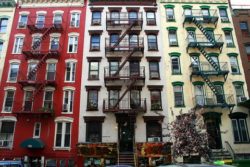
Apartments in New York City. Image credit: Esteban Chiner.
Can New Yorkers rent their homes during the summer while they are away? Homeowners and tenants rent their homes while they are away this summer, but the question is: Is this Legal?
Prior to 2010, New York landlords were renting out rooms for as little as seven days. These types of rentals are still going on. However, rentals of this type, called transient rentals, for the most part, are illegal and the penalties could be costly. In 2010, the New York State legislature amended the Multiple Dwelling Law to clarify the 30-day minimum required stay for rentals in multiple dwellings and private homes. A multiple dwelling is a residence or home of three or more families living independently of each other. Under the New York City Building Code and Housing Maintenance Code, private dwellings are subject to the Multiple Dwelling Law as well. A private dwelling is any building or structure designed and occupied for residential purposes by not more than two families. The law classifies short-term rentals as any rental for less than 30 days. The 30-day requirement was passed in response to landlords pushing lower-income renters out of their buildings in order to rent to tourists for shorter, more lucrative periods.
The Mayor’s Office of Special Enforcement has been investigating illegal rentals throughout the city. Their goal is to not only preserve affordable housing and residential housing, but to preserve the safety and livability in all communities. Therefore, under the Multiple Dwelling Law rentals for fewer than 30 days are prohibited unless a permanent resident is present during the stay. However, under New York’s Housing Maintenance Code, no more than two short-term renters or “boarders” can stay with the permanent resident at a time. Homeowners and tenants must be aware of the risks and potential penalties they can face if they illegally rent their home.
The violations come from the Housing Maintenance Code, Building Code, and Zoning Resolution. Administrative Code § 28-301.1 provides that: “The owner shall be responsible at all times to maintain the building…in a safe and code-compliant manner…” Thus, building owners are responsible for the actions of their tenants. Common violations for transient use under the Multiple Dwelling Law include inadequate sprinklers for transient use, inadequate egress for transient use, and for inadequate fire alarm for transient use. Penalties can range from $1,000 to $1,000 a day up to 45 days, totaling $45,000. The prospect of daily penalties even for unknowing violations encourages owners’ proactive efforts to know what is occurring in their buildings. Private dwellings are subject to the same violations and penalties. Private dwelling owners could also face a penalty for occupancy violations. Transient rentals are contrary to the certificate of occupancy for permanent residences. New York State has also banned advertisements for rentals that are in violation of the Multiple Dwellings Law’s restriction on short-term rentals. The New York City Office of Special Enforcement enforces penalties for illegal advertisements. The first fine is $1,000, second fine is $5,000, and third fine is $7,500. The host will be fined for advertising the illegal listing. For a complete list of penalties, click here.
One option for tenants looking to rent this summer is to sublet. Tenants in an apartment with three or more units can sublease their apartment if they will be temporarily away for at least 30 days. Typically, residential leases prohibit tenants from subleasing their units without the landlord’s permission. Tenants who want to sublet should check their leases and talk to their landlords before engaging in any rentals. If a tenant violates their lease they could be in trouble with their landlord. A landlord may ask a tenant to surrender their lease for violations. Some violations could result in the tenant being sued, and tenants who get sued for eviction have a hard time renting in the future.
When asking for permission to sublease you must inform the owner by certified mail, no less than 30 days prior to the proposed subletting. The request must contain the term of the sublease, the name of the proposed sublessee, the business and permanent home address of the proposed sublessee, the reason for the sublet request, your address for the term of the sublease, written consent from any co-tenant or guarantor on the lease, and a copy of the proposed sublease (along with a copy of your lease, if available) acknowledged by the tenant and subtenant as a true copy of the sublease. The landlord has ten days to ask for additional information, which must be provided so long as the request is not burdensome. If the landlord fails to respond to the sublet request within 30 days, then a failure to respond is deemed consent. If the landlord denies the sublet on reasonable grounds, the tenant cannot sublet. If the landlord denies the sublet on unreasonable grounds, the tenant may sublet anyway, if the tenant followed the above steps.
Tenants in a rent stabilized apartment also have a right to sublease their apartment. Similar to subleasing a non-rent stabilized apartment, the owner may not unreasonably refuse such permission if the tenant followed the steps listed before. The New York Administrative Code regulates properties subject to rent stabilization and a tenant cannot charge a sublessee in a rent-stabilized apartment more than the stabilized rent.
In sum, if you are going away for less than 30 days and choose to rent, be aware of the range of penalties you will face.
CityLand previously covered the Court of Appeals decision on Airbnb law here.
By: David Mateen (David is a CityLaw Intern and a New York Law School Student, Class of 2019.)

